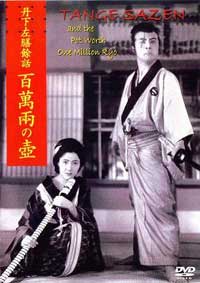
DENJIRO OKOCHI AS TANGE SAZEN
WITH THE MILLION RYO POT
There are many tales of Tange Sazen, but the tale regarding the treasure urn is most familiar.
This particular story was first filmed humorously in Sadao Yamanaka's Tange Sazen yowa: Hyakuman ryo no tsubo (Tange Sazen's Sidestory: The Pot Worth a Million Ryo, Nikkatsu, 1935) starring the kabuki-trained Denjiro Okochi as Tange Sazen.
Denjiro is in Japan as well remembered as any Hollywood giant of the past is remembered in America. But in the west he is apt to be familiar only to fans of Akira Kurosawa, having starred in Sanshiro Sugata: Judo Saga (1943), The Men who Tread on the Tiger's Tail (1945) in which he plays the monk Benkei, & No Regrets for our Youth (1946).
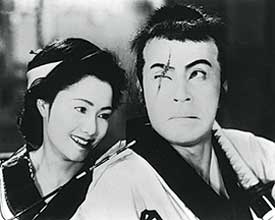 The 1935 film also stars the one-named actress "Kiyozo" as Ofuji who runs the arcade bow & arrow gallery & plays shamisen. We also see Kunitaro Sawamura as Genzaburo Yagyu whose wife sold the pot to junk dealers for a pittance, & Reisaburo Yamamoto as Yokichi the peasant to admires Sazen, recurring characters in Tange Sazen films for decades to come. The 1935 film also stars the one-named actress "Kiyozo" as Ofuji who runs the arcade bow & arrow gallery & plays shamisen. We also see Kunitaro Sawamura as Genzaburo Yagyu whose wife sold the pot to junk dealers for a pittance, & Reisaburo Yamamoto as Yokichi the peasant to admires Sazen, recurring characters in Tange Sazen films for decades to come.
Tange is eager to protect the treasure pot from finding its way into the hands of the evil lord, while protecting an orphan who has been keeping a goldfish in the titular urn.
It is filmed with an upbeat comic tone, odd for a character regarded as a "monster," but there was something of the comic relief about Tange Sazen from his inception, & he only became a semi-nihilistic antihero over time. As played by Denjiro, though, he's a gruff guy not easy to get to know, although those who look beyond his sorry looks & crabby temper love him.
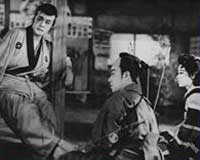 The movements of the urn provide an excuse to get to know the various characters. It is not an action film per se, though the few bits of swordplay we do see are very nicely done. Denjiro creates for the character a rapid & nearly hopping left-hand sword style that is showy & exciting. The movements of the urn provide an excuse to get to know the various characters. It is not an action film per se, though the few bits of swordplay we do see are very nicely done. Denjiro creates for the character a rapid & nearly hopping left-hand sword style that is showy & exciting.
Later versions would have villains who were much more appalling & brutal swordfights with lots of death, but the 1935 version doesn't even reveal the awful manner by which Sazen lost an arm & an eye.
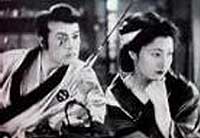 Sadao Yamanaka was a humanist director in a time of war. The film of his that has been most often shown in the west is Humanity & Paper Balloons (1937) set in the Tokugawa era, the original "tragic ronin" story. It is one of only three of his films that survive, the others being The Pot Worth a Million Ryo & Soshun Kochiyama. Sadao Yamanaka was a humanist director in a time of war. The film of his that has been most often shown in the west is Humanity & Paper Balloons (1937) set in the Tokugawa era, the original "tragic ronin" story. It is one of only three of his films that survive, the others being The Pot Worth a Million Ryo & Soshun Kochiyama.
After making Humanity & Paper Balloons, his twenty-second film, the military establishment perceived that he was not sufficiently supporting their agenda, & Tange Sazen's smart-ass comments against the phony virtues of samurai stood among the things that got the director in trouble.
His punishment was to be shipped off to the front in Manchuria, where he was killed on the battlefield at age twenty-eight. His last letter home said in part, "To my seniors & friends I say lastly, please make good movies."
The DVD art for The Pot Worth a Million Ryu is shown in the illustration at left, followed by two stills for this black & white classic.
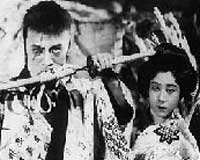 A filmography restricted to the Tange Sazen films that starred Denjiro Okochi is slightly complicated, as he moved from studio to studio. A filmography restricted to the Tange Sazen films that starred Denjiro Okochi is slightly complicated, as he moved from studio to studio.
He was the very first actor to play Tange Sazen in a talkie, in Daisuke Ito's Tange Sazen Dai-ippen, (Nikattsu, 1933) & Tange Sazen Kengeki-no-maki (Nikkatsu, 1934). The two films together constituted an epic, & this was also Ito's first talkie.
Only forty-seven minutes of this two-film version survive. A still from it decorates this paragraph.
Daisuke Ito had previously done a silent film trilogy likewise starring Denjiro. These consisted of Shinban Ohokaseidan Dai-ippen (1928), Shinban Ohokaseidan Dai-nihen (1928) & Shinban Ohokaseidan Dai-sanpen (1928).
Although the silents were vehicles for benshi narrators, I nevertheless wish it were possible to see especially the Ito versions, as my suspicions are that he would never leave the story to the benshi alone, & created rich enough films that he was able to recycle the same scenarios in his first talkie.
Other directors also adapted his Tange Sazen scenarios for early talkies. And importantly, it would be in these films that Denjiro created the amazing physical mannerisms that made Sazen stand out so powerfully as a treat for the eyes. Alas, so far as I know, these three silent films do not survive.
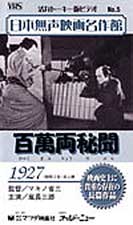 It is worth noting in passing other silent era Tange Sazen directors & stars. Tokuma Dan played Sazen in Shinban Ohokaseidan Suzukawa Genjuro no Maki (1928), Shinban Ohokaseidan Chuhen (1928), & Shinban Ohokaseidan Kohen (1928), all directed by Goro Hirose. It is worth noting in passing other silent era Tange Sazen directors & stars. Tokuma Dan played Sazen in Shinban Ohokaseidan Suzukawa Genjuro no Maki (1928), Shinban Ohokaseidan Chuhen (1928), & Shinban Ohokaseidan Kohen (1928), all directed by Goro Hirose.
Chozaburo Arashi played Sazen in Shinban Ohokaseidan Zenpen (1928) & Shinban Ohokaseidan Chuhen (1928), directed by Fumitaro Futagawa. Clearly 1928 was not a year for filmgoers to avoid Tange Sazen.
Chozaburo was a big star of the era, & films & fragments survive of him playing Musashi Miyamoto, Tsukigata Hanpeita, Kurama Tengu, & other figures who would be refilmed in just about every decade after, including a version of the million ryo pot tale in a trilogy called: Hyakumanryo Hibun Zen, Hyakumanryo Hibun Chu, & Hyakumanryo Hibun Kohen. (The Million Ryo Secret, I, II, III, 1927) directed by Makino Shozo.
124 minutes total survive of Chozaburo's Hyakumanryo Hibun trilogy, available from Matsuda Film Productions; the box is shown near this paragraph.
But to return to Denjiro, he reprised the role in 1935 in the story of the Million Ryo Pot (or Urn), the first time Sazen spoke on-screen; then followed up with additional Sazen films, although with another studio. There were seven Sazen films starring Denjiro between 1936 & 1940, in two sets of three & four respectively. These two clutches of films together constitute:
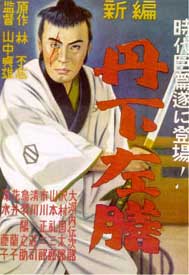 1. Tange Sazen Nikko-no-maki. 1936
1. Tange Sazen Nikko-no-maki. 1936
directed by Kunio Watanabe
2. Tange Sazen Aizo-maken Hen. 1937
directed by Kunio Watanabe
3. Tange Sazen Kanketsu-hoko Hen. 1937
directed by Kunio Watanabe
4. Shinpen Tange Sazen: Yoto-hen. Toho, 1938
Directed by Kunio Watanabe
5. Shinpen Tange Sazen: Hayate-hen. Toho, 1939
Directed by Satsuo Yamamoto
6. Shinpen Tange Sazen: Sekigan-no-maki. Toho, 1939
Directed by Obuo Nakagawa
7. Shinpen Tange Sazen: Koiguruma no maki. Toho, 1940
Directed by Ryo Hagiwara
The earlier three films are a distinct set from the second four. In Shinpen set we get a veritable "origins" tale spread across four short films.
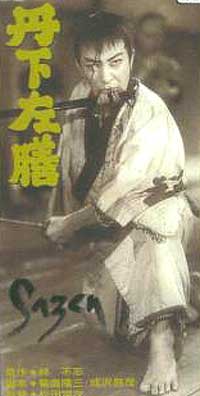 Denjiro as Tange Sazen starts out as a samurai retainer who in the first film loses his position & becomes a ronin; in the second film loses an arm; in the third loses an eye, so that in the fourth film he is finally presented as "the lefty" one-eyed one-armed swordsman. Denjiro as Tange Sazen starts out as a samurai retainer who in the first film loses his position & becomes a ronin; in the second film loses an arm; in the third loses an eye, so that in the fourth film he is finally presented as "the lefty" one-eyed one-armed swordsman.
There followed a long hiatus, then Daiei Studios revived the series & got Denjiro once again to star. The same year, with Tange Sazen (1952).
Shochiku Studios tried to revive the series at the same time, having Tsumasaburo Bando as Sazen, & directed by Sadaji Matsuda.
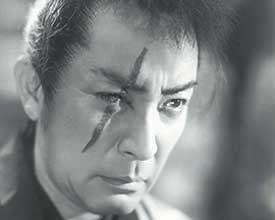 Greatly beloved though Bando was -- & he'd been a superstar since the silent era -- in the public mind this character still belonged to Denjiro. Bando's version thus did no business & did not result in the intended series. Greatly beloved though Bando was -- & he'd been a superstar since the silent era -- in the public mind this character still belonged to Denjiro. Bando's version thus did no business & did not result in the intended series.
Reproduced here, the poster for the first of the new Sazen trilogy starring Denjiro, showing Sazen kneeling with sword's sheath in his teeth.
The close-up of Denjiro's face with eye slashed is from the same 1952 film. The cameo-shaped illustration on the VHS box immediately below is for the 1953 episode. The script scenarios were Daisuke Ito's; the directors were Masahiro Makino & Kenji Misumi. The series consists of:
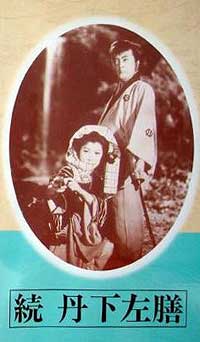 1. Tange Sazen
1. Tange Sazen
(Tange Sazen I) Daiei, 1952
Director: Masahiro Makino
2. Zoku Tange Sazen
(Tange Sazen II) Daiei, 1953
Director: Masahiro Makino
3. Tange Sazen: Hyakuman-ryu no tsubo
(Tange Sazen III: The Kokezaru Pot). Daiei, 1954
Director: Kenji Misume
The DVD box art for the 1954 Kenji Misumi-directed episode is shown immediately below. With this film, Denjiro's last outing as Tange Sazen comes full circle, as it was a remake of his 1935 film directed by Sadao Yamanaka, the well-known tale of the million-ryu urn.
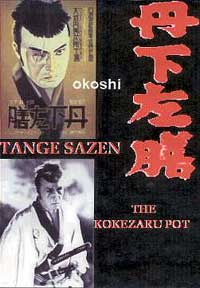 Another trilogy by one of the best jidai-geki directors, Masahiro Makino, who had previously directed Denjiro in the role, has not seen light of day in half a century. Those films starred Michitaro Mizushima, who once again the public would not accept in Denjiro's role. Another trilogy by one of the best jidai-geki directors, Masahiro Makino, who had previously directed Denjiro in the role, has not seen light of day in half a century. Those films starred Michitaro Mizushima, who once again the public would not accept in Denjiro's role.
They were all directed by Makino for 1956 release from Nikkatsu Studios: Tange Sazen: Kenun no maki (Tange Sazen & the Kenun Sword), Tange Sazen: Unkon no maki (Tange Sazen & the Unkon Sword) & Tange Sazen kanketsu (Tange Sazen Concluded).
These reportedly provide a gloomier & eerie take on Tange Sazen. Either the public didn't want to see Mizushima in Denjiro's role, or they didn't want to see Tange Sazen without his edge of humor.
But then Masahiro Makino jumped over to Toei studios to help his brother-in-law Teiji Matsuda (aka Sadatsugu Matsuda) start the series over again. With the more lighthearted approach of Ryutaro Otomo at center stage, the public was finally willing to embrace a second actor in the role. The series was long-running through the 1950s & 1960s.
I'll eventually post a second article focusing on Otomo's performances in the role, so will note for the present that one of the films starring Otomo does retell yet again the story of the urn: Tange Sazen: Ketteiban (Secret of the Golden Spell, Toei, 1958) directed by Teiji Matsuda.
copyright © by Paghat the Ratgirl
|
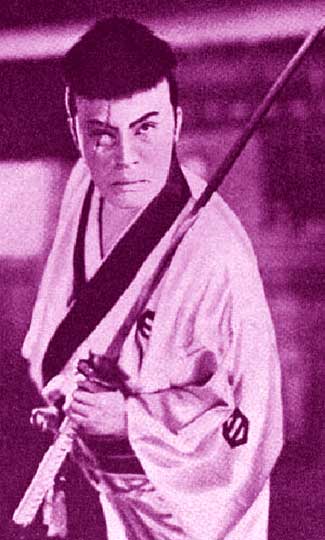

 The 1935 film also stars the one-named actress "Kiyozo" as Ofuji who runs the arcade bow & arrow gallery & plays shamisen. We also see Kunitaro Sawamura as Genzaburo Yagyu whose wife sold the pot to junk dealers for a pittance, & Reisaburo Yamamoto as Yokichi the peasant to admires Sazen, recurring characters in Tange Sazen films for decades to come.
The 1935 film also stars the one-named actress "Kiyozo" as Ofuji who runs the arcade bow & arrow gallery & plays shamisen. We also see Kunitaro Sawamura as Genzaburo Yagyu whose wife sold the pot to junk dealers for a pittance, & Reisaburo Yamamoto as Yokichi the peasant to admires Sazen, recurring characters in Tange Sazen films for decades to come. The movements of the urn provide an excuse to get to know the various characters. It is not an action film per se, though the few bits of swordplay we do see are very nicely done. Denjiro creates for the character a rapid & nearly hopping left-hand sword style that is showy & exciting.
The movements of the urn provide an excuse to get to know the various characters. It is not an action film per se, though the few bits of swordplay we do see are very nicely done. Denjiro creates for the character a rapid & nearly hopping left-hand sword style that is showy & exciting. Sadao Yamanaka was a humanist director in a time of war. The film of his that has been most often shown in the west is Humanity & Paper Balloons (1937) set in the Tokugawa era, the original "tragic ronin" story. It is one of only three of his films that survive, the others being The Pot Worth a Million Ryo & Soshun Kochiyama.
Sadao Yamanaka was a humanist director in a time of war. The film of his that has been most often shown in the west is Humanity & Paper Balloons (1937) set in the Tokugawa era, the original "tragic ronin" story. It is one of only three of his films that survive, the others being The Pot Worth a Million Ryo & Soshun Kochiyama.

 1. Tange Sazen Nikko-no-maki. 1936
1. Tange Sazen Nikko-no-maki. 1936 Denjiro as Tange Sazen starts out as a samurai retainer who in the first film loses his position & becomes a ronin; in the second film loses an arm; in the third loses an eye, so that in the fourth film he is finally presented as "the lefty" one-eyed one-armed swordsman.
Denjiro as Tange Sazen starts out as a samurai retainer who in the first film loses his position & becomes a ronin; in the second film loses an arm; in the third loses an eye, so that in the fourth film he is finally presented as "the lefty" one-eyed one-armed swordsman. Greatly beloved though Bando was -- & he'd been a superstar since the silent era -- in the public mind this character still belonged to Denjiro. Bando's version thus did no business & did not result in the intended series.
Greatly beloved though Bando was -- & he'd been a superstar since the silent era -- in the public mind this character still belonged to Denjiro. Bando's version thus did no business & did not result in the intended series. 1. Tange Sazen
1. Tange Sazen Another trilogy by one of the best jidai-geki directors, Masahiro Makino, who had previously directed Denjiro in the role, has not seen light of day in half a century. Those films starred Michitaro Mizushima, who once again the public would not accept in Denjiro's role.
Another trilogy by one of the best jidai-geki directors, Masahiro Makino, who had previously directed Denjiro in the role, has not seen light of day in half a century. Those films starred Michitaro Mizushima, who once again the public would not accept in Denjiro's role.